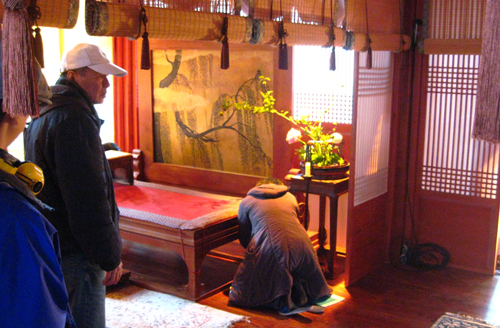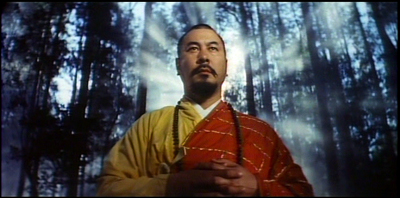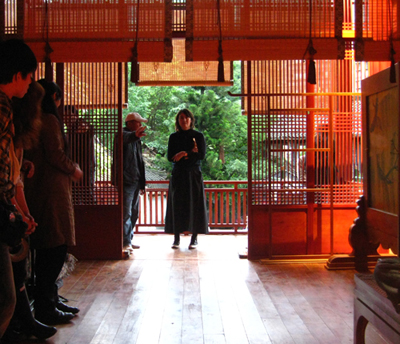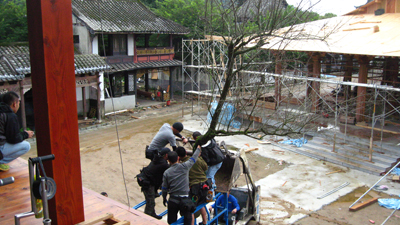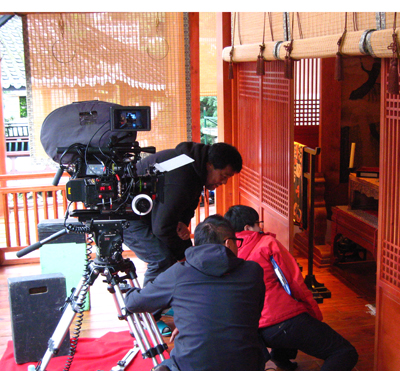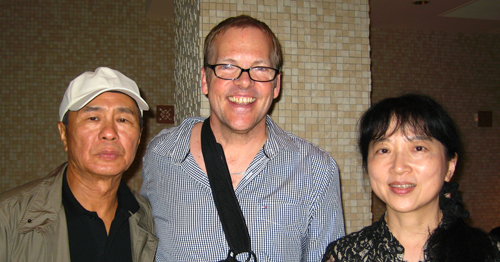Hou Hsiao-hsien oversees set details for The Assassin.
DB here:
For many years now, contemporary Chinese cinema has found success with costume action pictures like Red Cliff [2] and Painted Skin: The Resurrection [3]. Even prestige arthouse directors got into the act. Ang Lee’s Crouching Tiger, Hidden Dragon [4] (2000) and Zhang Yimou’s Hero [5] (2002) made the popular wuxia (martial chivalry) film respectable, and now we’re about to see several more examples.
Wong Kar-wai, who already found festival and arthouse recognition with Ashes of Time [6] (1994) is (apparently) finally finishing [7] The Grandmaster, a tale centered on Bruce Lee’s teacher Ip Man. Jia Zhang-ke, whose demanding, slowly-paced films Platform [8] and The World [9] got scant distribution in the US, is making a wuxia. Even more surprising is the fact that Hou Hsiao-hsien, master of the gradually unfolding long take, has turned his attention to martial arts. The Assassin, Hou’s first film in several years, is currently shooting in Taiwan.
James Udden is the author of the most comprehensive and authoritative book on Hou, No Man an Island: The Cinema of Hou Hsiao-hsien [10]. For that project he interviewed Hou many times. Jim’s new project, a historical study of how Taiwanese and Iranian cinema became central to world film culture, compelled him to revisit Hou in December. “Hou’s screenwriter, Chu Tian-wen, informed me that if any interview were to happen before I left, it would have to happen on the set itself — if I did not mind. How could I refuse?” Jim has kindly chronicled his visit in the guest blog below, one mixing information with the unabashed admiration of the true fan.
Hou after Hu
Made in Taiwan: A Touch of Zen (King Hu, 1971).
“The first day of a costume picture always goes like this,” Hou Hsiao-hsien remarked to me. It was Assassin’s first day of shooting in Taiwan. The actors had been on call for make-up since 6:30 am were ready to go by 8:00. Now it was late in the morning and the camera had yet to roll. Slowly some of the actors made their way from the dressing into the open air, lounging around in their Tang-dynasty garb, waiting. Shu Qi [12], the Taiwanese star who launched her career in Hong Kong and has now gained wide exposure (If You Are the One [13], Millennium Mambo [14], The Transporter [15]), is among Hou’s cast, and she walked onto the set briefly to inspect something.
Hou made it sound like he had done all this before. And it’s true that he has been at his best with historical material, not contemporary subject matter. Yet never before has Hou gone this far back into the past. Flowers of Shanghai [16] was set in the late 19th century, but this film is set in the 9th century during the Tang dynasty, generally considered the peak of Chinese civilization.
More striking, The Assassin is a wuxia film. The outstanding figure in this genre’s rich history was King Hu, who revolutionized the wuxia in the 1960s and 1970s. A mainland émigré director who began directing in Hong Kong, Hu shot his best work in Taiwan and is a towering figure in that nation’s film history. He was known for his passionate authenticity in costume and settings, but also for his eccentric editing techniques, sometimes involving shots that last a mere fraction of a second.
Hou seeks authenticity no less fervently than Hu, but in terms of editing, he has been the older director’s polar opposite. A cut is rare in any Hou film. Often the shots last on average well over a minute, with Flowers of Shanghai averaging close to three minutes per shot. A year ago I asked Hou if the wuxia tradition would force him to abandon his signature long take. His answer was typical: “ I won’t know the answer to that until I actually get on the set.”
That’s where my visit came in. Hou and his crew had just returned from shooting scenes in mainland China. Now they were starting to film on the lot of the Central Motion Picture Corporation, the government-sponsored production facility that had given birth to the Taiwanese New Cinema of the 1980s.
Many know Hou’s work best through Café Lumière [17] (2003) and The Flight of the Red Balloon [18] (2008), both of which got fairly wide distribution in the West. However, Hou’s lasting reputation as a master is built largely on two things: the remarkable string of films he made in the 1980s as part of the Taiwanese New Cinema trend, and his later works that delve into the historical past, most of all City of Sadness (1989), The Puppetmaster [19] (1993) and Flowers of Shanghai (1998). In these films, Hou explored the subtleties and complexities of mise-en-scène to an extent almost without parallel save for Kenji Mizoguchi. He also explored historical issues in ways almost without precedent. City of Sadness, in particular, gave a human face to a period of Taiwanese history that had long been kept in darkness.
How, through what concrete production decisions, did Hou achieve his lingering, riveting scenes—solemn long takes capturing the textures and tempos of the past? My 2009 book had to rely on secondary reports and my interviews with Hou and his collaborators. Now for the first time, I could observe firsthand.
Admittedly, during my visit I got only a snapshot of the production process. After a prolonged period of financing and preproduction, The Assassin will be shot over several months in China, Taiwan and Japan. According to Hou’s team, it will not be released until 2014. Still, two days on a set did confirm some things about Hou’s creative process, while also leaving some lingering hints of what this major project will be like.
Meticulous mise-en-scène
Sound designer Tu Tu-chih and director of photography Mark Lee Ping-bin.
In my book on Hou, I argued that only in Taiwan could Hou have had the career he had. This is not merely due to the particular set of historical circumstances and institutional pressures and opportunities. It is also because he was fortunate to find a creative team that has sustained his vision.
Prominent members include Mark Lee Ping-bin, the director of photography, and Tu Tu-chih, the sound designer. For Lee and Tu, shooting on the CMPC lot must have seemed like a homecoming, since both had learned their craft at this same studio in the early 1980s. Since then they have become arguably among the best of their respective fields in Asia, if not the world. Then there’s the remarkable production designer, Huang Wen-ying, who has worked with Hou since 1995 and who also is Hou’s main producer. For her this is clearly a dream project. Seeing this calm, soft-spoken yet efficient crew at work in tandem was unforgettable: they seemed to be working hard and meditating at the same time.
Years ago Hou said in an interview that perhaps he is too meticulous when it comes to mise-en-scène. This clearly has not changed. On the first day the camera was not yet on the set. Overheard snippets of Hou’s extended discussions with Huang Wen-ying, Mark Lee and others, gave the impression initially that he was going to shoot an interior scene one way, then another, only by the end of the evening to lead me to believe it had changed once again. Then on the second day, the first day of actual shooting, I returned in the morning to discover that the scene was covered from yet another angle.
Throughout that morning, that single setup underwent three more metamorphoses. Hou and his colleagues tinkered with the set and props so extensively that they broke for lunch before actually shooting — this despite the actors all being on call since around 6:30 am. Not bounded by the union rules typical on a Hollywood set, Hou at times was directly involved in adjusting several minute details. Hou is as meticulous as ever.
Hou never uses storyboards or shot lists. He does not even write out dialogue beforehand for the actors. His scenes have always grown out of the specifics of a setting—usually real locations that spark his imaginative staging and lighting. His modus operandi is to then respond directly to the atmosphere he finds himself in, no matter how long that takes. Everybody who works for him seems to understand this.
Now he had plenty of atmosphere to inspire him. Since original Tang-dynasty buildings are difficult to come by, two large, full-scale structures were being erected from scratch. These were solid buildings that I suspect will be worth a lot of money someday, and they were so large that the CMPC lot could barely contain them.
In the building that was finished, what struck me was the craftsmanship. From the hardwood floors to the intricate slatted, lattice room dividers, the woodwork in the finished structure was immaculate down to the details. Even the tiniest props, including flowers, were real, and breathtaking. Nearby in the production office was evidence of the exhaustive historical research behind this. Drawings and blueprints were to be found among hundreds of over-sized books on Chinese art and architecture.
Although the intricate sets for Flowers of Shanghai had been made in Taiwan in the later 1990s, Huang Wen-ying hired Vietnamese woodworkers to craft them. She claimed they would give slight “French” flavor to the set, evoking a strain of Chinese architecture particular to a foreign concession. I asked if this was the case this time. She laughed, “No, this time it is all ‘Made in Taiwan.’” I sensed some real pride in that statement, and for good reason.
Here lies the answer why this project has taken so long. Last year in Japan, Hou told me that some constraints were financial. The budget, currently reported at between US$12 and 14.5 million, had to be raised from various sources. Above all, though, it took time for Hou’s team to master all of the period details of the Tang dynasty. When it comes to mise-en-scène, no stone is left unturned. In fact, just about every stone, and everything else, is at some point toyed with by Hou himself.
Brushwork, not ballpoint
Crew and Hou with producer and production designer Huang Wen-ying.
Lighting is often the most time-consuming aspect of a film shoot, and you’d expect it to be particularly prolonged on a Hou project. Anyone who has seen either The Puppetmaster or Flowers of Shanghai on the big screen knows the supple gradations of light and shadows typical of a Hou shot. Yet back in 2005, Huang Wen-ying told me that Mark Lee works rather quickly to set up his lighting schemes. I found that almost incredible. Now I know it’s true.
Of all the changes that occurred on the first morning of actual shooting I saw, very few involved the lighting. The illumination was pretty much all set up by the time I arrived around 8:30. Over the course of the morning, only one lighting instrument was added, another was adjusted slightly, and a flag was added to one side.
For the most part Lee had to consult the continuity person about all the subtle changes occurring on the set. Over the course of the morning, Hou and crew dramatically changed the backgrounds of the shot. They hung a new gossamer cloth, added a folding screen revamped with gold leaf, and hoisted a leafless tree that would be visible in the distance. In the picture below you can see the second building under construction.
Lee would observe all these changes and would then confer with Hou as to how things would look on camera. At one point Lee was crouched with the continuity person, pointing at some detail for her to examine from a particular angle. She jotted points down in her large notebook.
In all his films for Hou, Lee’s exceptionally low lighting levels and deep, layered shadow areas would give even Gordon Willis a run for his money. Lee’s subtle lighting has always registered magnificently on film. Accordingly, The Assassin is being shot entirely on Kodak stock, even though digital would be somewhat cheaper. “To shoot on digital instead of film stock,” Lee explains, “is like being asked to paint with a ball-point pen instead of a brush.” No digital work will be done until post-production. I suspect that so long as there is some film stock to be found anywhere, at whatever cost, a Hou film will use it.
Back to basics?
Now that Hou has been on the set, what clues do we have to the result? What will a Hou wuxia film look like?
It’s of course too soon to say, but I did see signs that Hou wants to return to basics. Up to 1993 he notoriously executed long takes with little to no camera movement. Since then his camera has become very mobile — perhaps most notably in the endlessly arcing camera of Flowers of Shanghai. But what I saw in the Assassin shoot was a camera set only on a tripod, not a dolly, and placed at a considerable distance. The arrangement didn’t permit any movements except perhaps some pans or tilts for reframing.
I venture this guess: this will be a Hou film first, and a wuxia film a distant second. It will likely be a wuxia film unlike any other.
On that second day, I had to bid my goodbye to Hou before he had even started shooting. It should have been disappointing to not actually see Hou say “action” or “cut.” Yet this could not be further from the truth. First, I did get my interview late on the first day, fittingly on the CMPC lot. Second, I saw and heard much more than I could have ever expected. When I left America for Taipei, the prospect of being on Hou’s set was the furthest thing from my mind. I came home feeling like the luckiest guy in the world.
More background on Hou’s Assassin project can be found at Film Business Asia [24] and Screen Daily [25]. I discuss principles of Hou’s staging in Chapter 5 of Figures Traced in Light and on this site, in a supplementary essay on his early work [26] and in this blog entry [27].
Our previous guest post was Tim Smith’s perennially popular “Watching you watch THERE WILL BE BLOOD.” [28]
Hou Hsiao-hsien, James Udden, and Hou’s screenwriter and long-time collaborator Chu Tian-wen; Japan, 2011.
P. S. 7 January 2013: Wong Kar-wai’s The Grandmaster made its censorship deadline and was screened in Beijing [30]. Thanks to Ray Pride and Movie City News [31] curated headlines for the link.
P. P. S. 8 January 2013: James Marsh has a rapturous early review of The Grandmaster at twitchfilm [32].
P. P. S. 8 January 2013, later: Maggie Lee provides an equally enthralled review [33] in Variety.
P.P.P.S. 16 January 2014: Shooting on The Assassin is said to be wrapped. See Stephen Cremin at Film Business Asia. [34]
